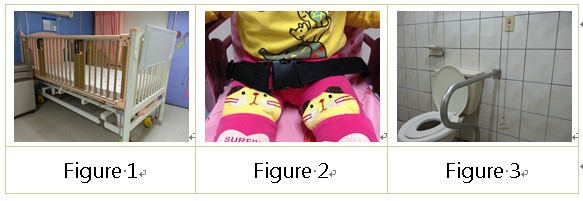Importance of Fall Prevention
Injuries caused by falls could be flesh wound or as serious as bone fracture or intracranial hemorrhage, and even life-threatening. Children are a high-risk group for fall and hence how to prevent children from falling and injury is worth the attention and valuation from the public.
What kind of children is more likely to fall?
- Those under 5 years old.
- Those having experience with falls.
- Those with confusing consciousness, drowsiness, dullness, and unclearness about people, times and location.
- Blurry vision or blind.
- Headache, dizziness, orthostatic hypotension.
- Persons with unstable steps and need aids for walking.
- Persons who frequently need to get off bed or assistance from family to handle stool and urine.
- Persons using sedative sleeping pill, anesthetic painkiller, blood pressure drop, diuretics, antihistamine, blood sugar drop, antiepileptic, and mydriatic.
Fall Prevention Method
Use bed rails ( Figure 1 )
- The nurse will assist you to pull up the bed rail during hospitalization and inform the caregiver of the instruction of bed rail. The bed rail should pay attention to the correct use of bed rail.
- Not the following matters for using bed rail:
- After pulling up the bed rail, check if the hinge correctly latches to the groove to avoid sudden fall of bed rail that leads to danger.
- In case of discovering abnormal use of bed rail, notify the nurse.
- In case the family needs to leave temporarily when the child is sleeping in bed, please pull up the bed rail to prevent fall.
- Note if the child climbs the bed rail:
The bed rail is about 60 cm and pay attention if the children’s abdomen exceeds the highest area of the bed rail. Do not let the child stand next to the bedrail to prevent falling to the ground by flipping over the bed rail.
- Do not let the child stand on the bed, play game or walk around.
Getting off bed
- Those taking antihistamines or analgesic sleeping pill will likely to have dizziness and weak lower extremities. The caregiver shall help the ill child to progressively get off the bed by lifting the bed by 45 degree, then slowly sit up and sit on the bed side if not experiencing any discomfort. Swing the legs for 5 minutes to get the body adjusted. Then, put the feet on the ground to see if the leg or feet are weak. Only get off the bed in the absence of such problems.
- In case the ill child could not walk stably, do not let the child get off the bed without help and someone should always company and use wheelchair.
Walking ( Figure 2 )
- Please wear comfortable cloth and stable shoes. Bare feet are prohibited.
- Do not let children stand on the intravenous drip rack. Please pay attention to the drip tube to prevent falling or tripping from the tube.
- Children with unstable steps or use walking aids will need to be companied by family when moving from the bed.
- Unfold the wheelchair completely before use. Pull up the pedal and fix the brake before carrying the children to the wheelchair, in addition to buckling up to avoid wheel slipping and causing injury.
- Do not let children run in the corridor of the ward to prevent colliding with other people.
- Please keep the floor dry. If the floor is dampened, please notify the nurse so the cleaning staff will be notified to clean up.
Going to the Bathroom ( Figure 3 )
- Note if the floor in and outside of the bathroom is wet. Walk carefully to prevent slipping.
- Children with immobility shall be companied by family in the bathroom to prevent accident.
- If the bathroom is dark inside, turn on the light.
- Take the motion slow when squatting and standing up in the bathroom.
- For emergency situation in the bathroom, please press the bell to notify the nurse.
Other Precautions
- To use sedative sleeping pill or anesthetic painkiller, go to the bathroom first and lay down on the bed for 1 hour after taking the medicine to avoid fall from dizziness.
- If the patient feels powerless after taking the medicine, please use the bed pan or urinal next to the bed.
- When the blood platelet count falls under 100,000, pay attention to the activity safety after getting off the bed. The fall could lead to serious consequence such as intracranial hemorrhage. For assistance, use the Nurse Call Bell to notify the nurse for assistance.


